Creating Restaurant Customer Value: Role of Dining Experience
VerifiedAdded on 2022/09/18
|15
|8052
|27
Report
AI Summary
This report, derived from a student assignment, investigates the multifaceted nature of customer value creation within the restaurant industry. It examines the significance of various dining experience attributes, including food quality, service quality, and the often-overlooked role of other customers, in shaping customer perceptions and behaviors. The research, conducted through a quantitative approach utilizing structural equation modeling, proposes and tests a conceptual model that links restaurant attributes to customer value and behavioral intentions. The study, based on data collected from a restaurant group in Istanbul, confirms the sequential relationship between restaurant attributes, customer value, and behavioral intentions. Furthermore, the findings highlight the importance of other customers as an integral part of the dining experience. The report emphasizes the need for restaurateurs to understand and manage different restaurant attributes to meet diverse customer needs, ultimately influencing their overall perceived value and future actions.
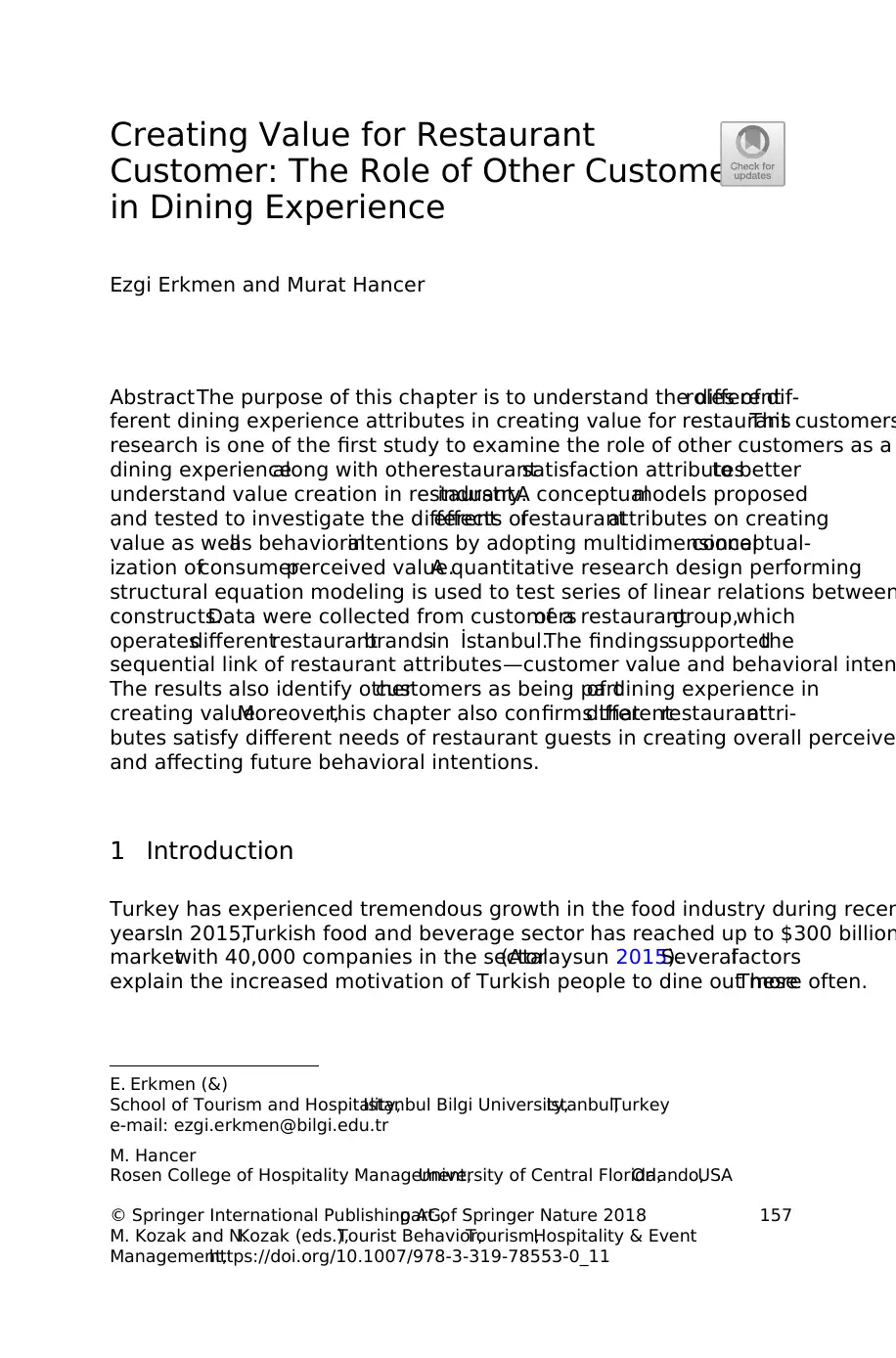
Creating Value for Restaurant
Customer: The Role of Other Customers
in Dining Experience
Ezgi Erkmen and Murat Hancer
AbstractThe purpose of this chapter is to understand the differentroles of dif-
ferent dining experience attributes in creating value for restaurant customersThis
research is one of the first study to examine the role of other customers as a
dining experiencealong with otherrestaurantsatisfaction attributesto better
understand value creation in restaurantindustry.A conceptualmodelis proposed
and tested to investigate the differenteffects ofrestaurantattributes on creating
value as wellas behavioralintentions by adopting multidimensionalconceptual-
ization ofconsumerperceived value.A quantitative research design performing
structural equation modeling is used to test series of linear relations between
constructs.Data were collected from customersof a restaurantgroup,which
operatesdifferentrestaurantbrandsin İstanbul.The findingssupportedthe
sequential link of restaurant attributes—customer value and behavioral inten
The results also identify othercustomers as being partof dining experience in
creating value.Moreover,this chapter also confirms thatdifferentrestaurantattri-
butes satisfy different needs of restaurant guests in creating overall perceive
and affecting future behavioral intentions.
1 Introduction
Turkey has experienced tremendous growth in the food industry during recen
years.In 2015,Turkish food and beverage sector has reached up to $300 billion
marketwith 40,000 companies in the sector(Atalaysun 2015).Severalfactors
explain the increased motivation of Turkish people to dine out more often.These
E. Erkmen (&)
School of Tourism and Hospitality,Istanbul Bilgi University,Istanbul,Turkey
e-mail: ezgi.erkmen@bilgi.edu.tr
M. Hancer
Rosen College of Hospitality Management,University of Central Florida,Orlando,USA
© Springer International Publishing AG,part of Springer Nature 2018
M. Kozak and N.Kozak (eds.),Tourist Behavior,Tourism,Hospitality & Event
Management,https://doi.org/10.1007/978-3-319-78553-0_11
157
Customer: The Role of Other Customers
in Dining Experience
Ezgi Erkmen and Murat Hancer
AbstractThe purpose of this chapter is to understand the differentroles of dif-
ferent dining experience attributes in creating value for restaurant customersThis
research is one of the first study to examine the role of other customers as a
dining experiencealong with otherrestaurantsatisfaction attributesto better
understand value creation in restaurantindustry.A conceptualmodelis proposed
and tested to investigate the differenteffects ofrestaurantattributes on creating
value as wellas behavioralintentions by adopting multidimensionalconceptual-
ization ofconsumerperceived value.A quantitative research design performing
structural equation modeling is used to test series of linear relations between
constructs.Data were collected from customersof a restaurantgroup,which
operatesdifferentrestaurantbrandsin İstanbul.The findingssupportedthe
sequential link of restaurant attributes—customer value and behavioral inten
The results also identify othercustomers as being partof dining experience in
creating value.Moreover,this chapter also confirms thatdifferentrestaurantattri-
butes satisfy different needs of restaurant guests in creating overall perceive
and affecting future behavioral intentions.
1 Introduction
Turkey has experienced tremendous growth in the food industry during recen
years.In 2015,Turkish food and beverage sector has reached up to $300 billion
marketwith 40,000 companies in the sector(Atalaysun 2015).Severalfactors
explain the increased motivation of Turkish people to dine out more often.These
E. Erkmen (&)
School of Tourism and Hospitality,Istanbul Bilgi University,Istanbul,Turkey
e-mail: ezgi.erkmen@bilgi.edu.tr
M. Hancer
Rosen College of Hospitality Management,University of Central Florida,Orlando,USA
© Springer International Publishing AG,part of Springer Nature 2018
M. Kozak and N.Kozak (eds.),Tourist Behavior,Tourism,Hospitality & Event
Management,https://doi.org/10.1007/978-3-319-78553-0_11
157
Paraphrase This Document
Need a fresh take? Get an instant paraphrase of this document with our AI Paraphraser
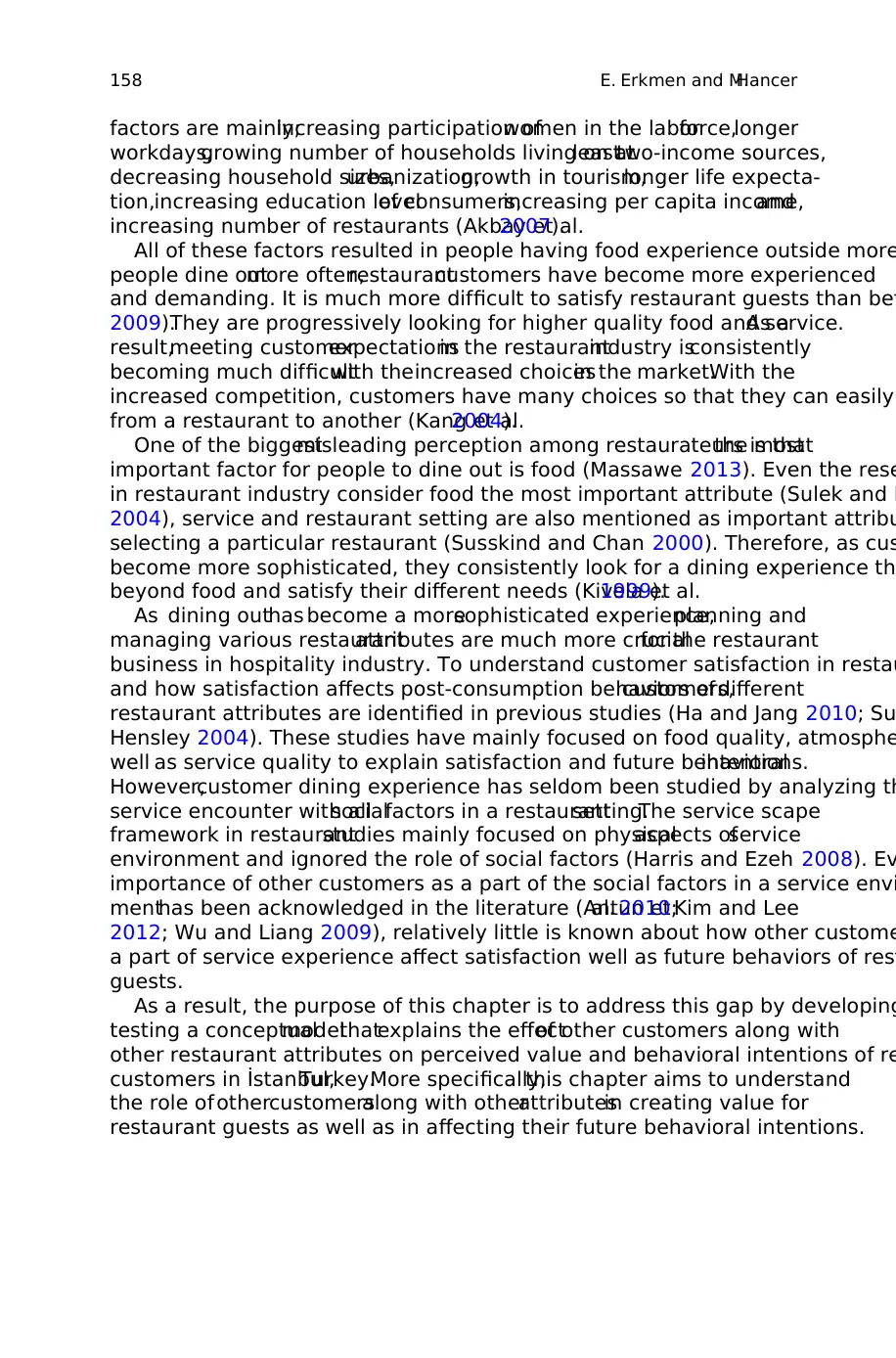
factors are mainly;increasing participation ofwomen in the laborforce,longer
workdays,growing number of households living on atleasttwo-income sources,
decreasing household sizes,urbanization,growth in tourism,longer life expecta-
tion,increasing education levelof consumers,increasing per capita income,and
increasing number of restaurants (Akbay et al.2007).
All of these factors resulted in people having food experience outside more
people dine outmore often,restaurantcustomers have become more experienced
and demanding. It is much more difficult to satisfy restaurant guests than bef
2009).They are progressively looking for higher quality food and service.As a
result,meeting customerexpectationsin the restaurantindustry isconsistently
becoming much difficultwith theincreased choicesin the market.With the
increased competition, customers have many choices so that they can easily
from a restaurant to another (Kang et al.2004).
One of the biggestmisleading perception among restaurateurs is thatthe most
important factor for people to dine out is food (Massawe 2013). Even the rese
in restaurant industry consider food the most important attribute (Sulek and H
2004), service and restaurant setting are also mentioned as important attribu
selecting a particular restaurant (Susskind and Chan 2000). Therefore, as cus
become more sophisticated, they consistently look for a dining experience th
beyond food and satisfy their different needs (Kivela et al.1999).
As dining outhas become a moresophisticated experience,planning and
managing various restaurantattributes are much more crucialfor the restaurant
business in hospitality industry. To understand customer satisfaction in restau
and how satisfaction affects post-consumption behaviors ofcustomers,different
restaurant attributes are identified in previous studies (Ha and Jang 2010; Su
Hensley 2004). These studies have mainly focused on food quality, atmosphe
well as service quality to explain satisfaction and future behavioralintentions.
However,customer dining experience has seldom been studied by analyzing th
service encounter with allsocialfactors in a restaurantsetting.The service scape
framework in restaurantstudies mainly focused on physicalaspects ofservice
environment and ignored the role of social factors (Harris and Ezeh 2008). Ev
importance of other customers as a part of the social factors in a service envi
menthas been acknowledged in the literature (Antun etal. 2010;Kim and Lee
2012; Wu and Liang 2009), relatively little is known about how other custome
a part of service experience affect satisfaction well as future behaviors of rest
guests.
As a result, the purpose of this chapter is to address this gap by developing
testing a conceptualmodelthatexplains the effectof other customers along with
other restaurant attributes on perceived value and behavioral intentions of re
customers in İstanbul,Turkey.More specifically,this chapter aims to understand
the role of othercustomersalong with otherattributesin creating value for
restaurant guests as well as in affecting their future behavioral intentions.
158 E. Erkmen and M.Hancer
workdays,growing number of households living on atleasttwo-income sources,
decreasing household sizes,urbanization,growth in tourism,longer life expecta-
tion,increasing education levelof consumers,increasing per capita income,and
increasing number of restaurants (Akbay et al.2007).
All of these factors resulted in people having food experience outside more
people dine outmore often,restaurantcustomers have become more experienced
and demanding. It is much more difficult to satisfy restaurant guests than bef
2009).They are progressively looking for higher quality food and service.As a
result,meeting customerexpectationsin the restaurantindustry isconsistently
becoming much difficultwith theincreased choicesin the market.With the
increased competition, customers have many choices so that they can easily
from a restaurant to another (Kang et al.2004).
One of the biggestmisleading perception among restaurateurs is thatthe most
important factor for people to dine out is food (Massawe 2013). Even the rese
in restaurant industry consider food the most important attribute (Sulek and H
2004), service and restaurant setting are also mentioned as important attribu
selecting a particular restaurant (Susskind and Chan 2000). Therefore, as cus
become more sophisticated, they consistently look for a dining experience th
beyond food and satisfy their different needs (Kivela et al.1999).
As dining outhas become a moresophisticated experience,planning and
managing various restaurantattributes are much more crucialfor the restaurant
business in hospitality industry. To understand customer satisfaction in restau
and how satisfaction affects post-consumption behaviors ofcustomers,different
restaurant attributes are identified in previous studies (Ha and Jang 2010; Su
Hensley 2004). These studies have mainly focused on food quality, atmosphe
well as service quality to explain satisfaction and future behavioralintentions.
However,customer dining experience has seldom been studied by analyzing th
service encounter with allsocialfactors in a restaurantsetting.The service scape
framework in restaurantstudies mainly focused on physicalaspects ofservice
environment and ignored the role of social factors (Harris and Ezeh 2008). Ev
importance of other customers as a part of the social factors in a service envi
menthas been acknowledged in the literature (Antun etal. 2010;Kim and Lee
2012; Wu and Liang 2009), relatively little is known about how other custome
a part of service experience affect satisfaction well as future behaviors of rest
guests.
As a result, the purpose of this chapter is to address this gap by developing
testing a conceptualmodelthatexplains the effectof other customers along with
other restaurant attributes on perceived value and behavioral intentions of re
customers in İstanbul,Turkey.More specifically,this chapter aims to understand
the role of othercustomersalong with otherattributesin creating value for
restaurant guests as well as in affecting their future behavioral intentions.
158 E. Erkmen and M.Hancer
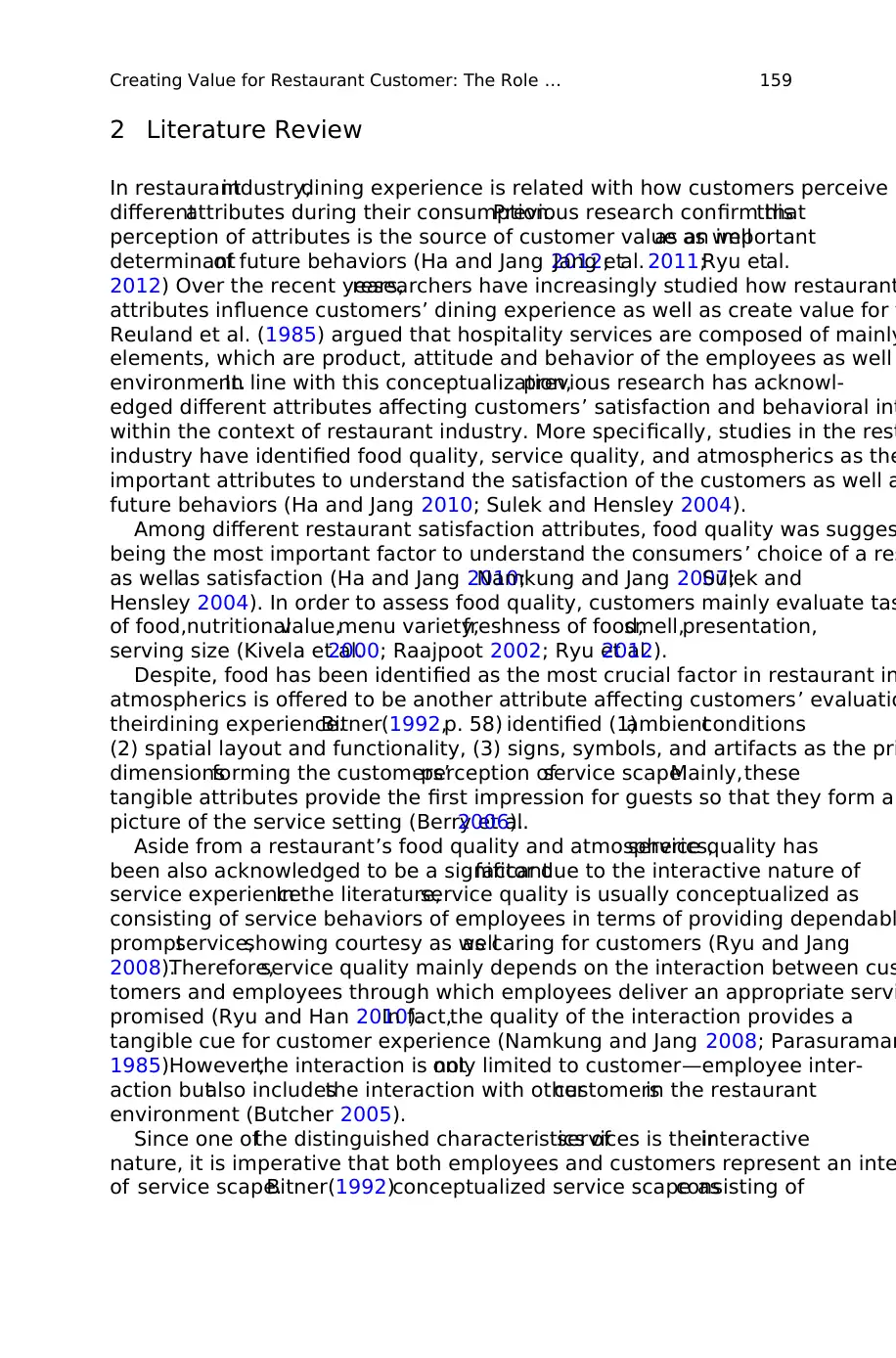
2 Literature Review
In restaurantindustry,dining experience is related with how customers perceive
differentattributes during their consumption.Previous research confirm thatthis
perception of attributes is the source of customer value as wellas an important
determinantof future behaviors (Ha and Jang 2012;Jang etal. 2011;Ryu etal.
2012) Over the recent years,researchers have increasingly studied how restaurant
attributes influence customers’ dining experience as well as create value for t
Reuland et al. (1985) argued that hospitality services are composed of mainly
elements, which are product, attitude and behavior of the employees as well
environment.In line with this conceptualization,previous research has acknowl-
edged different attributes affecting customers’ satisfaction and behavioral int
within the context of restaurant industry. More specifically, studies in the rest
industry have identified food quality, service quality, and atmospherics as the
important attributes to understand the satisfaction of the customers as well a
future behaviors (Ha and Jang 2010; Sulek and Hensley 2004).
Among different restaurant satisfaction attributes, food quality was sugges
being the most important factor to understand the consumers’ choice of a res
as wellas satisfaction (Ha and Jang 2010;Namkung and Jang 2007;Sulek and
Hensley 2004). In order to assess food quality, customers mainly evaluate tas
of food,nutritionalvalue,menu variety,freshness of food,smell,presentation,
serving size (Kivela et al.2000; Raajpoot 2002; Ryu et al.2012).
Despite, food has been identified as the most crucial factor in restaurant in
atmospherics is offered to be another attribute affecting customers’ evaluatio
theirdining experience.Bitner(1992,p. 58) identified (1)ambientconditions
(2) spatial layout and functionality, (3) signs, symbols, and artifacts as the pri
dimensionsforming the customers’perception ofservice scape.Mainly,these
tangible attributes provide the first impression for guests so that they form a
picture of the service setting (Berry et al.2006).
Aside from a restaurant’s food quality and atmospherics,service quality has
been also acknowledged to be a significantfactor due to the interactive nature of
service experience.In the literature,service quality is usually conceptualized as
consisting of service behaviors of employees in terms of providing dependabl
promptservice,showing courtesy as wellas caring for customers (Ryu and Jang
2008).Therefore,service quality mainly depends on the interaction between cus
tomers and employees through which employees deliver an appropriate servi
promised (Ryu and Han 2010).In fact,the quality of the interaction provides a
tangible cue for customer experience (Namkung and Jang 2008; Parasuraman
1985).However,the interaction is notonly limited to customer—employee inter-
action butalso includesthe interaction with othercustomersin the restaurant
environment (Butcher 2005).
Since one ofthe distinguished characteristics ofservices is theirinteractive
nature, it is imperative that both employees and customers represent an inte
of service scape.Bitner(1992)conceptualized service scape asconsisting of
Creating Value for Restaurant Customer: The Role … 159
In restaurantindustry,dining experience is related with how customers perceive
differentattributes during their consumption.Previous research confirm thatthis
perception of attributes is the source of customer value as wellas an important
determinantof future behaviors (Ha and Jang 2012;Jang etal. 2011;Ryu etal.
2012) Over the recent years,researchers have increasingly studied how restaurant
attributes influence customers’ dining experience as well as create value for t
Reuland et al. (1985) argued that hospitality services are composed of mainly
elements, which are product, attitude and behavior of the employees as well
environment.In line with this conceptualization,previous research has acknowl-
edged different attributes affecting customers’ satisfaction and behavioral int
within the context of restaurant industry. More specifically, studies in the rest
industry have identified food quality, service quality, and atmospherics as the
important attributes to understand the satisfaction of the customers as well a
future behaviors (Ha and Jang 2010; Sulek and Hensley 2004).
Among different restaurant satisfaction attributes, food quality was sugges
being the most important factor to understand the consumers’ choice of a res
as wellas satisfaction (Ha and Jang 2010;Namkung and Jang 2007;Sulek and
Hensley 2004). In order to assess food quality, customers mainly evaluate tas
of food,nutritionalvalue,menu variety,freshness of food,smell,presentation,
serving size (Kivela et al.2000; Raajpoot 2002; Ryu et al.2012).
Despite, food has been identified as the most crucial factor in restaurant in
atmospherics is offered to be another attribute affecting customers’ evaluatio
theirdining experience.Bitner(1992,p. 58) identified (1)ambientconditions
(2) spatial layout and functionality, (3) signs, symbols, and artifacts as the pri
dimensionsforming the customers’perception ofservice scape.Mainly,these
tangible attributes provide the first impression for guests so that they form a
picture of the service setting (Berry et al.2006).
Aside from a restaurant’s food quality and atmospherics,service quality has
been also acknowledged to be a significantfactor due to the interactive nature of
service experience.In the literature,service quality is usually conceptualized as
consisting of service behaviors of employees in terms of providing dependabl
promptservice,showing courtesy as wellas caring for customers (Ryu and Jang
2008).Therefore,service quality mainly depends on the interaction between cus
tomers and employees through which employees deliver an appropriate servi
promised (Ryu and Han 2010).In fact,the quality of the interaction provides a
tangible cue for customer experience (Namkung and Jang 2008; Parasuraman
1985).However,the interaction is notonly limited to customer—employee inter-
action butalso includesthe interaction with othercustomersin the restaurant
environment (Butcher 2005).
Since one ofthe distinguished characteristics ofservices is theirinteractive
nature, it is imperative that both employees and customers represent an inte
of service scape.Bitner(1992)conceptualized service scape asconsisting of
Creating Value for Restaurant Customer: The Role … 159
⊘ This is a preview!⊘
Do you want full access?
Subscribe today to unlock all pages.

Trusted by 1+ million students worldwide
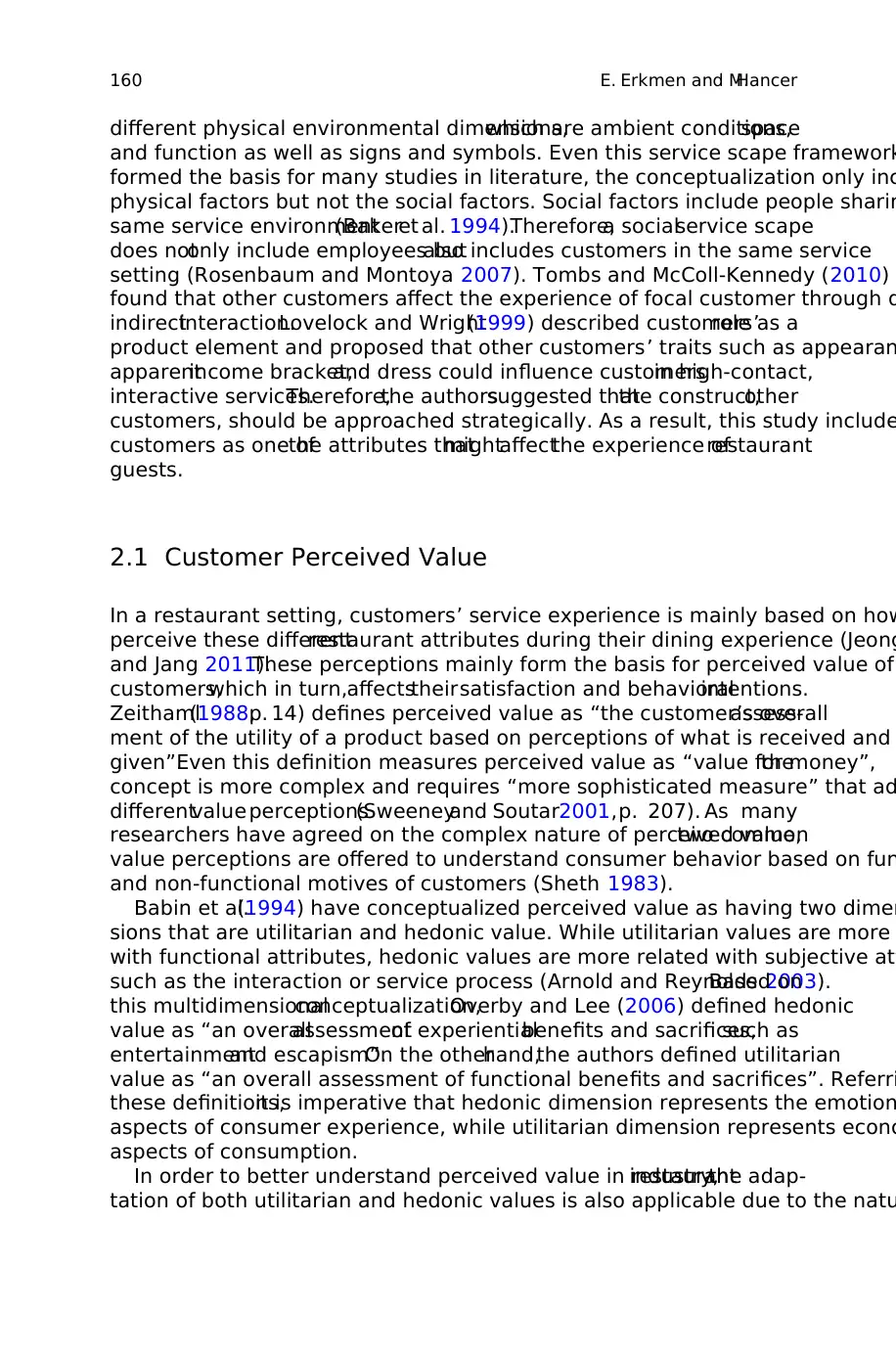
different physical environmental dimensions,which are ambient conditions,space
and function as well as signs and symbols. Even this service scape framework
formed the basis for many studies in literature, the conceptualization only inc
physical factors but not the social factors. Social factors include people sharin
same service environment(Bakeret al. 1994).Therefore,a socialservice scape
does notonly include employees butalso includes customers in the same service
setting (Rosenbaum and Montoya 2007). Tombs and McColl-Kennedy (2010)
found that other customers affect the experience of focal customer through d
indirectinteraction.Lovelock and Wright(1999) described customers’role as a
product element and proposed that other customers’ traits such as appearan
apparentincome bracket,and dress could influence customersin high-contact,
interactive services.Therefore,the authorssuggested thatthe construct,other
customers, should be approached strategically. As a result, this study include
customers as one ofthe attributes thatmightaffectthe experience ofrestaurant
guests.
2.1 Customer Perceived Value
In a restaurant setting, customers’ service experience is mainly based on how
perceive these differentrestaurant attributes during their dining experience (Jeong
and Jang 2011).These perceptions mainly form the basis for perceived value of
customers,which in turn,affectstheirsatisfaction and behavioralintentions.
Zeithaml(1988,p. 14) defines perceived value as “the customer’s overallassess-
ment of the utility of a product based on perceptions of what is received and
given”.Even this definition measures perceived value as “value for money”,the
concept is more complex and requires “more sophisticated measure” that ad
differentvalue perceptions(Sweeneyand Soutar2001,p. 207). As many
researchers have agreed on the complex nature of perceived value,two common
value perceptions are offered to understand consumer behavior based on fun
and non-functional motives of customers (Sheth 1983).
Babin et al.(1994) have conceptualized perceived value as having two dimen
sions that are utilitarian and hedonic value. While utilitarian values are more
with functional attributes, hedonic values are more related with subjective att
such as the interaction or service process (Arnold and Reynolds 2003).Based on
this multidimensionalconceptualization,Overby and Lee (2006) defined hedonic
value as “an overallassessmentof experientialbenefits and sacrifices,such as
entertainmentand escapism”.On the otherhand,the authors defined utilitarian
value as “an overall assessment of functional benefits and sacrifices”. Referri
these definitions,it is imperative that hedonic dimension represents the emotion
aspects of consumer experience, while utilitarian dimension represents econo
aspects of consumption.
In order to better understand perceived value in restaurantindustry,the adap-
tation of both utilitarian and hedonic values is also applicable due to the natu
160 E. Erkmen and M.Hancer
and function as well as signs and symbols. Even this service scape framework
formed the basis for many studies in literature, the conceptualization only inc
physical factors but not the social factors. Social factors include people sharin
same service environment(Bakeret al. 1994).Therefore,a socialservice scape
does notonly include employees butalso includes customers in the same service
setting (Rosenbaum and Montoya 2007). Tombs and McColl-Kennedy (2010)
found that other customers affect the experience of focal customer through d
indirectinteraction.Lovelock and Wright(1999) described customers’role as a
product element and proposed that other customers’ traits such as appearan
apparentincome bracket,and dress could influence customersin high-contact,
interactive services.Therefore,the authorssuggested thatthe construct,other
customers, should be approached strategically. As a result, this study include
customers as one ofthe attributes thatmightaffectthe experience ofrestaurant
guests.
2.1 Customer Perceived Value
In a restaurant setting, customers’ service experience is mainly based on how
perceive these differentrestaurant attributes during their dining experience (Jeong
and Jang 2011).These perceptions mainly form the basis for perceived value of
customers,which in turn,affectstheirsatisfaction and behavioralintentions.
Zeithaml(1988,p. 14) defines perceived value as “the customer’s overallassess-
ment of the utility of a product based on perceptions of what is received and
given”.Even this definition measures perceived value as “value for money”,the
concept is more complex and requires “more sophisticated measure” that ad
differentvalue perceptions(Sweeneyand Soutar2001,p. 207). As many
researchers have agreed on the complex nature of perceived value,two common
value perceptions are offered to understand consumer behavior based on fun
and non-functional motives of customers (Sheth 1983).
Babin et al.(1994) have conceptualized perceived value as having two dimen
sions that are utilitarian and hedonic value. While utilitarian values are more
with functional attributes, hedonic values are more related with subjective att
such as the interaction or service process (Arnold and Reynolds 2003).Based on
this multidimensionalconceptualization,Overby and Lee (2006) defined hedonic
value as “an overallassessmentof experientialbenefits and sacrifices,such as
entertainmentand escapism”.On the otherhand,the authors defined utilitarian
value as “an overall assessment of functional benefits and sacrifices”. Referri
these definitions,it is imperative that hedonic dimension represents the emotion
aspects of consumer experience, while utilitarian dimension represents econo
aspects of consumption.
In order to better understand perceived value in restaurantindustry,the adap-
tation of both utilitarian and hedonic values is also applicable due to the natu
160 E. Erkmen and M.Hancer
Paraphrase This Document
Need a fresh take? Get an instant paraphrase of this document with our AI Paraphraser
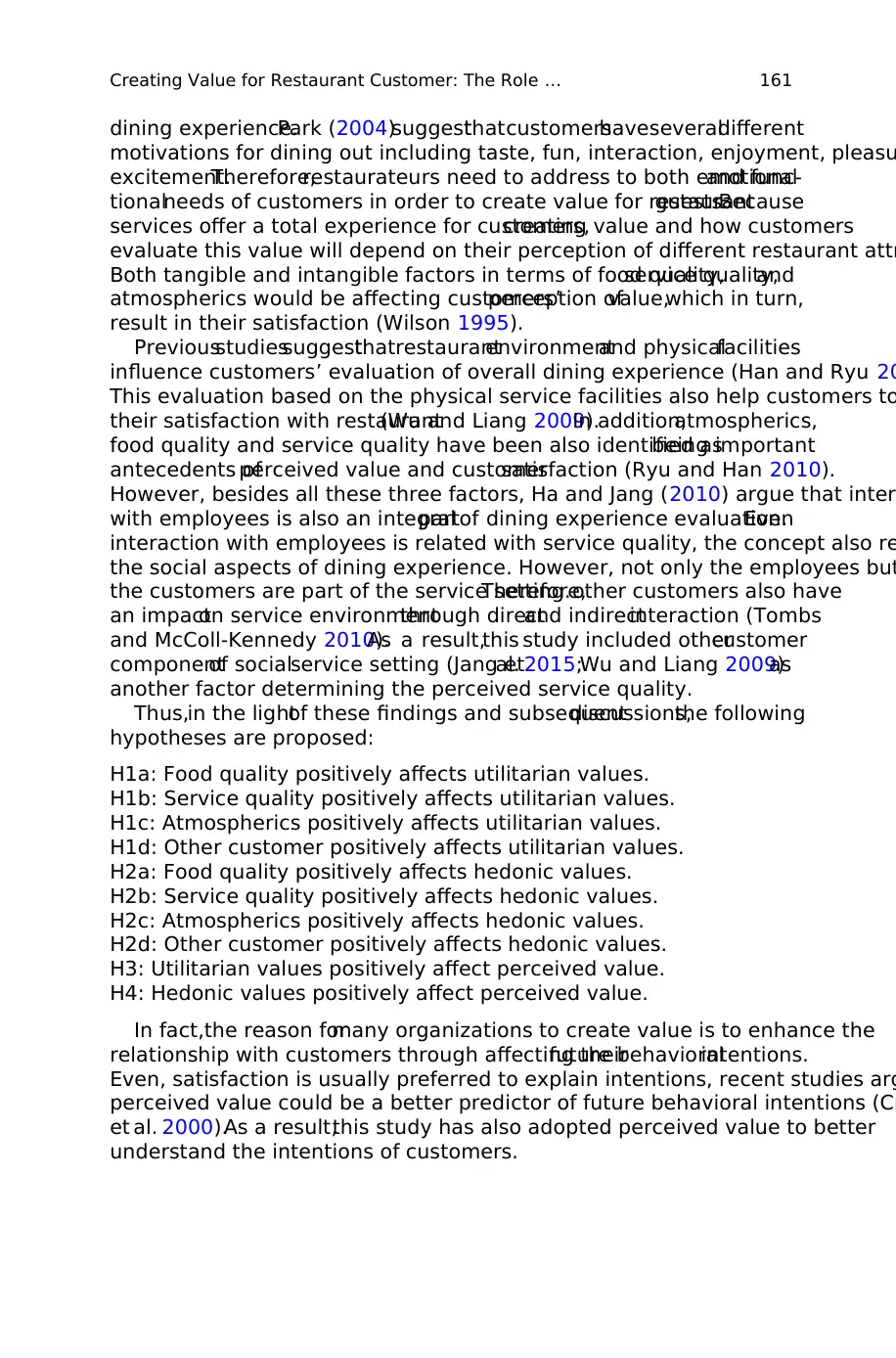
dining experience.Park (2004)suggestthatcustomershaveseveraldifferent
motivations for dining out including taste, fun, interaction, enjoyment, pleasu
excitement.Therefore,restaurateurs need to address to both emotionaland func-
tionalneeds of customers in order to create value for restaurantguests.Because
services offer a total experience for customers,creating value and how customers
evaluate this value will depend on their perception of different restaurant attr
Both tangible and intangible factors in terms of food quality,service quality,and
atmospherics would be affecting customers’perception ofvalue,which in turn,
result in their satisfaction (Wilson 1995).
Previousstudiessuggestthatrestaurantenvironmentand physicalfacilities
influence customers’ evaluation of overall dining experience (Han and Ryu 20
This evaluation based on the physical service facilities also help customers to
their satisfaction with restaurant(Wu and Liang 2009).In addition,atmospherics,
food quality and service quality have been also identified asbeing important
antecedents ofperceived value and customersatisfaction (Ryu and Han 2010).
However, besides all these three factors, Ha and Jang (2010) argue that inter
with employees is also an integralpartof dining experience evaluation.Even
interaction with employees is related with service quality, the concept also re
the social aspects of dining experience. However, not only the employees but
the customers are part of the service setting.Therefore,other customers also have
an impacton service environmentthrough directand indirectinteraction (Tombs
and McColl-Kennedy 2010).As a result,this study included othercustomer
componentof socialservice setting (Jang etal. 2015;Wu and Liang 2009)as
another factor determining the perceived service quality.
Thus,in the lightof these findings and subsequentdiscussions,the following
hypotheses are proposed:
H1a: Food quality positively affects utilitarian values.
H1b: Service quality positively affects utilitarian values.
H1c: Atmospherics positively affects utilitarian values.
H1d: Other customer positively affects utilitarian values.
H2a: Food quality positively affects hedonic values.
H2b: Service quality positively affects hedonic values.
H2c: Atmospherics positively affects hedonic values.
H2d: Other customer positively affects hedonic values.
H3: Utilitarian values positively affect perceived value.
H4: Hedonic values positively affect perceived value.
In fact,the reason formany organizations to create value is to enhance the
relationship with customers through affecting theirfuture behavioralintentions.
Even, satisfaction is usually preferred to explain intentions, recent studies arg
perceived value could be a better predictor of future behavioral intentions (Cr
et al. 2000).As a result,this study has also adopted perceived value to better
understand the intentions of customers.
Creating Value for Restaurant Customer: The Role … 161
motivations for dining out including taste, fun, interaction, enjoyment, pleasu
excitement.Therefore,restaurateurs need to address to both emotionaland func-
tionalneeds of customers in order to create value for restaurantguests.Because
services offer a total experience for customers,creating value and how customers
evaluate this value will depend on their perception of different restaurant attr
Both tangible and intangible factors in terms of food quality,service quality,and
atmospherics would be affecting customers’perception ofvalue,which in turn,
result in their satisfaction (Wilson 1995).
Previousstudiessuggestthatrestaurantenvironmentand physicalfacilities
influence customers’ evaluation of overall dining experience (Han and Ryu 20
This evaluation based on the physical service facilities also help customers to
their satisfaction with restaurant(Wu and Liang 2009).In addition,atmospherics,
food quality and service quality have been also identified asbeing important
antecedents ofperceived value and customersatisfaction (Ryu and Han 2010).
However, besides all these three factors, Ha and Jang (2010) argue that inter
with employees is also an integralpartof dining experience evaluation.Even
interaction with employees is related with service quality, the concept also re
the social aspects of dining experience. However, not only the employees but
the customers are part of the service setting.Therefore,other customers also have
an impacton service environmentthrough directand indirectinteraction (Tombs
and McColl-Kennedy 2010).As a result,this study included othercustomer
componentof socialservice setting (Jang etal. 2015;Wu and Liang 2009)as
another factor determining the perceived service quality.
Thus,in the lightof these findings and subsequentdiscussions,the following
hypotheses are proposed:
H1a: Food quality positively affects utilitarian values.
H1b: Service quality positively affects utilitarian values.
H1c: Atmospherics positively affects utilitarian values.
H1d: Other customer positively affects utilitarian values.
H2a: Food quality positively affects hedonic values.
H2b: Service quality positively affects hedonic values.
H2c: Atmospherics positively affects hedonic values.
H2d: Other customer positively affects hedonic values.
H3: Utilitarian values positively affect perceived value.
H4: Hedonic values positively affect perceived value.
In fact,the reason formany organizations to create value is to enhance the
relationship with customers through affecting theirfuture behavioralintentions.
Even, satisfaction is usually preferred to explain intentions, recent studies arg
perceived value could be a better predictor of future behavioral intentions (Cr
et al. 2000).As a result,this study has also adopted perceived value to better
understand the intentions of customers.
Creating Value for Restaurant Customer: The Role … 161
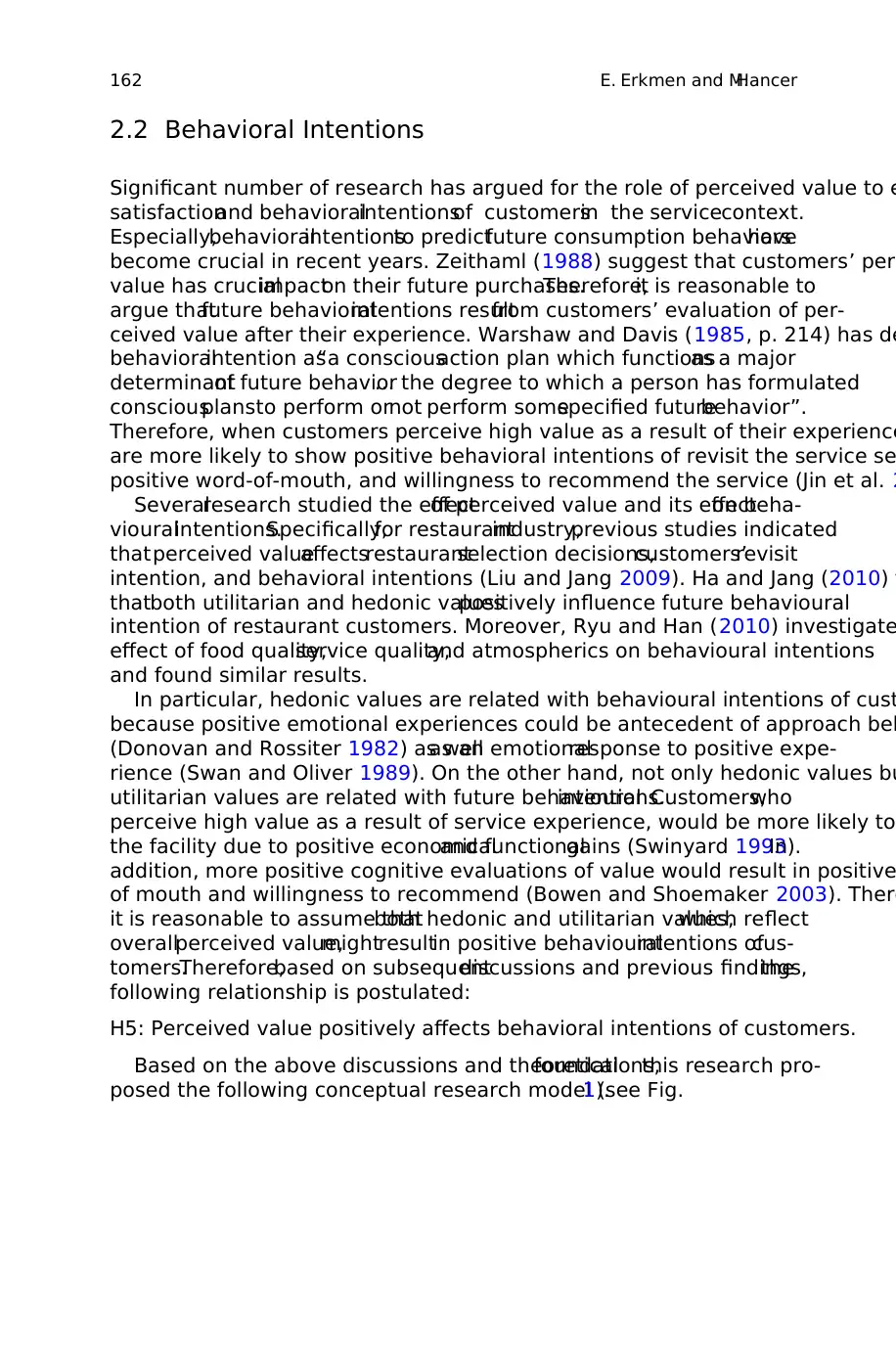
2.2 Behavioral Intentions
Significant number of research has argued for the role of perceived value to e
satisfactionand behavioralintentionsof customersin the servicecontext.
Especially,behavioralintentionsto predictfuture consumption behaviorshave
become crucial in recent years. Zeithaml (1988) suggest that customers’ perc
value has crucialimpacton their future purchases.Therefore,it is reasonable to
argue thatfuture behavioralintentions resultfrom customers’ evaluation of per-
ceived value after their experience. Warshaw and Davis (1985, p. 214) has de
behavioralintention as“a consciousaction plan which functionsas a major
determinantof future behavior… the degree to which a person has formulated
consciousplansto perform ornot perform somespecified futurebehavior”.
Therefore, when customers perceive high value as a result of their experience
are more likely to show positive behavioral intentions of revisit the service se
positive word-of-mouth, and willingness to recommend the service (Jin et al. 2
Severalresearch studied the effectof perceived value and its effecton beha-
viouralintentions.Specifically,for restaurantindustry,previous studies indicated
thatperceived valueaffectsrestaurantselection decisions,customers’revisit
intention, and behavioral intentions (Liu and Jang 2009). Ha and Jang (2010) f
thatboth utilitarian and hedonic valuespositively influence future behavioural
intention of restaurant customers. Moreover, Ryu and Han (2010) investigate
effect of food quality,service quality,and atmospherics on behavioural intentions
and found similar results.
In particular, hedonic values are related with behavioural intentions of cust
because positive emotional experiences could be antecedent of approach beh
(Donovan and Rossiter 1982) as wellas an emotionalresponse to positive expe-
rience (Swan and Oliver 1989). On the other hand, not only hedonic values bu
utilitarian values are related with future behaviouralintentions.Customers,who
perceive high value as a result of service experience, would be more likely to
the facility due to positive economicaland functionalgains (Swinyard 1993).In
addition, more positive cognitive evaluations of value would result in positive
of mouth and willingness to recommend (Bowen and Shoemaker 2003). There
it is reasonable to assume thatboth hedonic and utilitarian values,which reflect
overallperceived value,mightresultin positive behaviouralintentions ofcus-
tomers.Therefore,based on subsequentdiscussions and previous findings,the
following relationship is postulated:
H5: Perceived value positively affects behavioral intentions of customers.
Based on the above discussions and theoreticalfoundations,this research pro-
posed the following conceptual research model (see Fig.1).
162 E. Erkmen and M.Hancer
Significant number of research has argued for the role of perceived value to e
satisfactionand behavioralintentionsof customersin the servicecontext.
Especially,behavioralintentionsto predictfuture consumption behaviorshave
become crucial in recent years. Zeithaml (1988) suggest that customers’ perc
value has crucialimpacton their future purchases.Therefore,it is reasonable to
argue thatfuture behavioralintentions resultfrom customers’ evaluation of per-
ceived value after their experience. Warshaw and Davis (1985, p. 214) has de
behavioralintention as“a consciousaction plan which functionsas a major
determinantof future behavior… the degree to which a person has formulated
consciousplansto perform ornot perform somespecified futurebehavior”.
Therefore, when customers perceive high value as a result of their experience
are more likely to show positive behavioral intentions of revisit the service se
positive word-of-mouth, and willingness to recommend the service (Jin et al. 2
Severalresearch studied the effectof perceived value and its effecton beha-
viouralintentions.Specifically,for restaurantindustry,previous studies indicated
thatperceived valueaffectsrestaurantselection decisions,customers’revisit
intention, and behavioral intentions (Liu and Jang 2009). Ha and Jang (2010) f
thatboth utilitarian and hedonic valuespositively influence future behavioural
intention of restaurant customers. Moreover, Ryu and Han (2010) investigate
effect of food quality,service quality,and atmospherics on behavioural intentions
and found similar results.
In particular, hedonic values are related with behavioural intentions of cust
because positive emotional experiences could be antecedent of approach beh
(Donovan and Rossiter 1982) as wellas an emotionalresponse to positive expe-
rience (Swan and Oliver 1989). On the other hand, not only hedonic values bu
utilitarian values are related with future behaviouralintentions.Customers,who
perceive high value as a result of service experience, would be more likely to
the facility due to positive economicaland functionalgains (Swinyard 1993).In
addition, more positive cognitive evaluations of value would result in positive
of mouth and willingness to recommend (Bowen and Shoemaker 2003). There
it is reasonable to assume thatboth hedonic and utilitarian values,which reflect
overallperceived value,mightresultin positive behaviouralintentions ofcus-
tomers.Therefore,based on subsequentdiscussions and previous findings,the
following relationship is postulated:
H5: Perceived value positively affects behavioral intentions of customers.
Based on the above discussions and theoreticalfoundations,this research pro-
posed the following conceptual research model (see Fig.1).
162 E. Erkmen and M.Hancer
⊘ This is a preview!⊘
Do you want full access?
Subscribe today to unlock all pages.

Trusted by 1+ million students worldwide
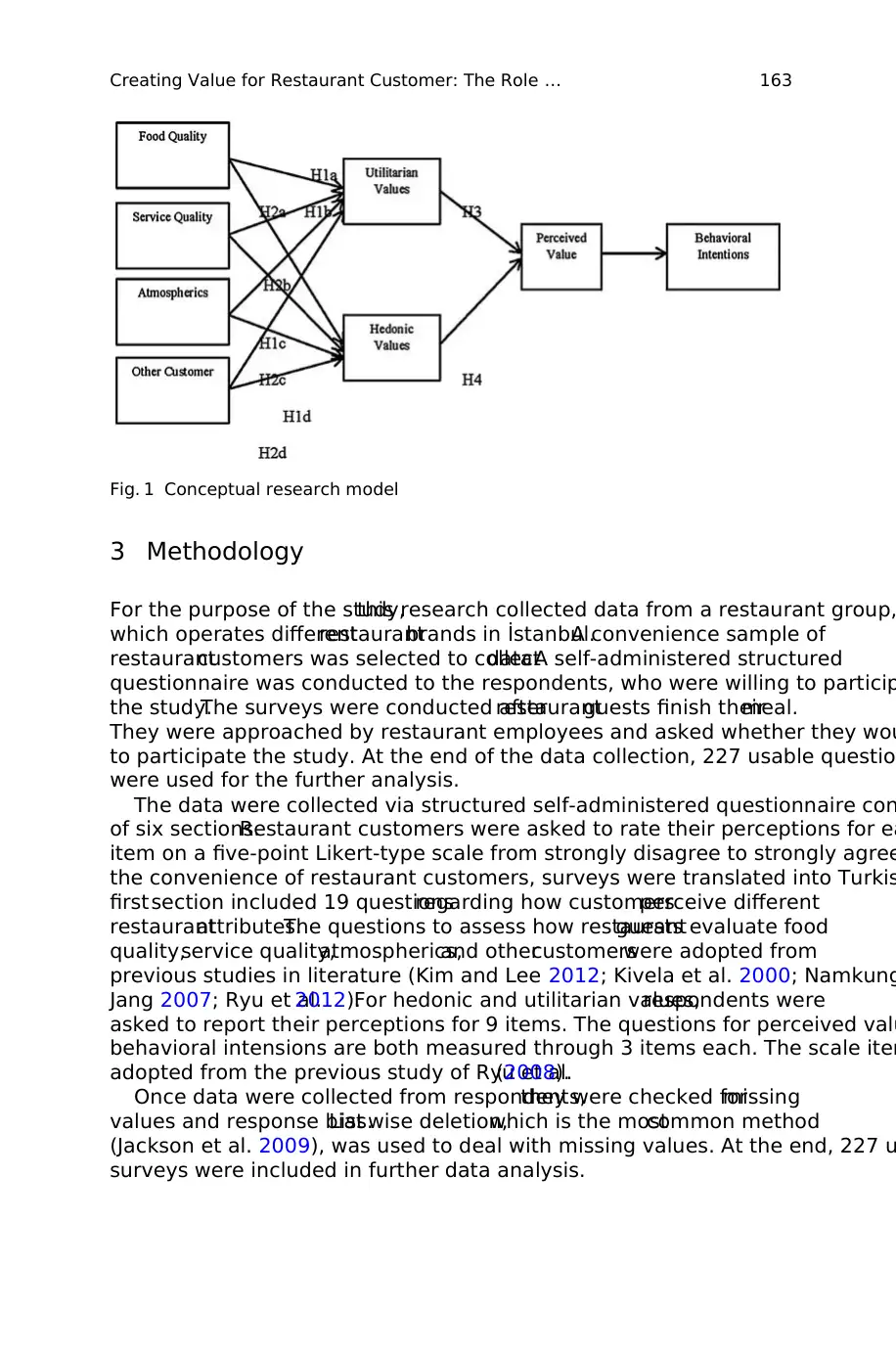
3 Methodology
For the purpose of the study,this research collected data from a restaurant group,
which operates differentrestaurantbrands in İstanbul.A convenience sample of
restaurantcustomers was selected to collectdata.A self-administered structured
questionnaire was conducted to the respondents, who were willing to particip
the study.The surveys were conducted afterrestaurantguests finish theirmeal.
They were approached by restaurant employees and asked whether they wou
to participate the study. At the end of the data collection, 227 usable questio
were used for the further analysis.
The data were collected via structured self-administered questionnaire con
of six sections.Restaurant customers were asked to rate their perceptions for ea
item on a five-point Likert-type scale from strongly disagree to strongly agree
the convenience of restaurant customers, surveys were translated into Turkis
first section included 19 questionsregarding how customersperceive different
restaurantattributes.The questions to assess how restaurantguests evaluate food
quality,service quality,atmospherics,and othercustomerswere adopted from
previous studies in literature (Kim and Lee 2012; Kivela et al. 2000; Namkung
Jang 2007; Ryu et al.2012).For hedonic and utilitarian values,respondents were
asked to report their perceptions for 9 items. The questions for perceived valu
behavioral intensions are both measured through 3 items each. The scale item
adopted from the previous study of Ryu et al.(2008).
Once data were collected from respondents,they were checked formissing
values and response bias.List wise deletion,which is the mostcommon method
(Jackson et al. 2009), was used to deal with missing values. At the end, 227 u
surveys were included in further data analysis.
Fig. 1 Conceptual research model
Creating Value for Restaurant Customer: The Role … 163
For the purpose of the study,this research collected data from a restaurant group,
which operates differentrestaurantbrands in İstanbul.A convenience sample of
restaurantcustomers was selected to collectdata.A self-administered structured
questionnaire was conducted to the respondents, who were willing to particip
the study.The surveys were conducted afterrestaurantguests finish theirmeal.
They were approached by restaurant employees and asked whether they wou
to participate the study. At the end of the data collection, 227 usable questio
were used for the further analysis.
The data were collected via structured self-administered questionnaire con
of six sections.Restaurant customers were asked to rate their perceptions for ea
item on a five-point Likert-type scale from strongly disagree to strongly agree
the convenience of restaurant customers, surveys were translated into Turkis
first section included 19 questionsregarding how customersperceive different
restaurantattributes.The questions to assess how restaurantguests evaluate food
quality,service quality,atmospherics,and othercustomerswere adopted from
previous studies in literature (Kim and Lee 2012; Kivela et al. 2000; Namkung
Jang 2007; Ryu et al.2012).For hedonic and utilitarian values,respondents were
asked to report their perceptions for 9 items. The questions for perceived valu
behavioral intensions are both measured through 3 items each. The scale item
adopted from the previous study of Ryu et al.(2008).
Once data were collected from respondents,they were checked formissing
values and response bias.List wise deletion,which is the mostcommon method
(Jackson et al. 2009), was used to deal with missing values. At the end, 227 u
surveys were included in further data analysis.
Fig. 1 Conceptual research model
Creating Value for Restaurant Customer: The Role … 163
Paraphrase This Document
Need a fresh take? Get an instant paraphrase of this document with our AI Paraphraser
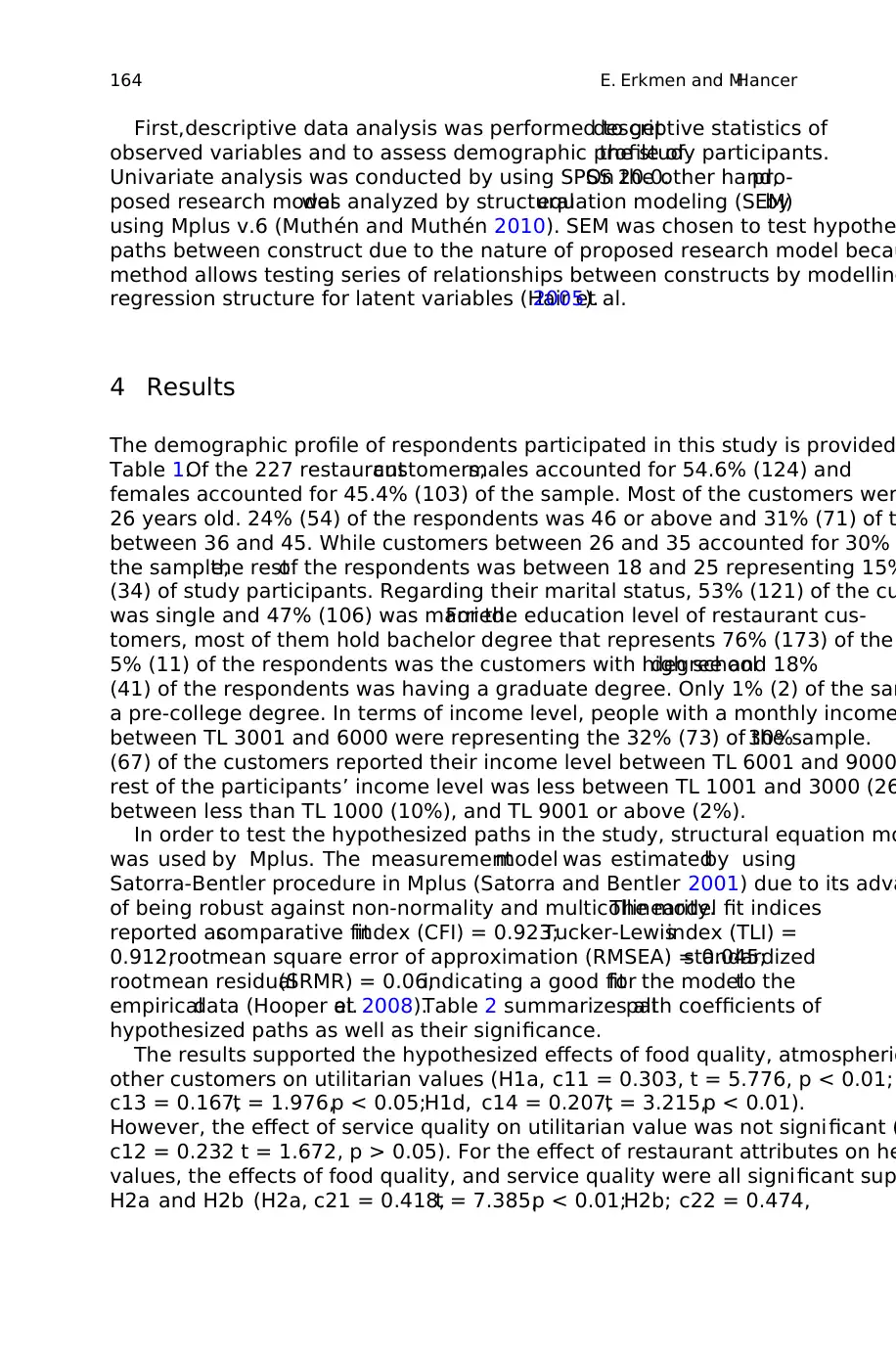
First,descriptive data analysis was performed to getdescriptive statistics of
observed variables and to assess demographic profile ofthe study participants.
Univariate analysis was conducted by using SPSS 20.0.On the other hand,pro-
posed research modelwas analyzed by structuralequation modeling (SEM)by
using Mplus v.6 (Muthén and Muthén 2010). SEM was chosen to test hypothe
paths between construct due to the nature of proposed research model becau
method allows testing series of relationships between constructs by modelling
regression structure for latent variables (Hair et al.2005).
4 Results
The demographic profile of respondents participated in this study is provided
Table 1.Of the 227 restaurantcustomers,males accounted for 54.6% (124) and
females accounted for 45.4% (103) of the sample. Most of the customers wer
26 years old. 24% (54) of the respondents was 46 or above and 31% (71) of t
between 36 and 45. While customers between 26 and 35 accounted for 30%
the sample,the restof the respondents was between 18 and 25 representing 15%
(34) of study participants. Regarding their marital status, 53% (121) of the cu
was single and 47% (106) was married.For the education level of restaurant cus-
tomers, most of them hold bachelor degree that represents 76% (173) of the
5% (11) of the respondents was the customers with high schooldegree and 18%
(41) of the respondents was having a graduate degree. Only 1% (2) of the sam
a pre-college degree. In terms of income level, people with a monthly income
between TL 3001 and 6000 were representing the 32% (73) of the sample.30%
(67) of the customers reported their income level between TL 6001 and 9000
rest of the participants’ income level was less between TL 1001 and 3000 (26
between less than TL 1000 (10%), and TL 9001 or above (2%).
In order to test the hypothesized paths in the study, structural equation mo
was used by Mplus. The measurementmodel was estimatedby using
Satorra-Bentler procedure in Mplus (Satorra and Bentler 2001) due to its adva
of being robust against non-normality and multicollinearity.The model fit indices
reported ascomparative fitindex (CFI) = 0.923;Tucker-Lewisindex (TLI) =
0.912;rootmean square error of approximation (RMSEA) = 0.045;standardized
rootmean residual(SRMR) = 0.06,indicating a good fitfor the modelto the
empiricaldata (Hooper etal. 2008).Table 2 summarizes allpath coefficients of
hypothesized paths as well as their significance.
The results supported the hypothesized effects of food quality, atmospheric
other customers on utilitarian values (H1a, c11 = 0.303, t = 5.776, p < 0.01;
c13 = 0.167,t = 1.976,p < 0.05;H1d, c14 = 0.207,t = 3.215,p < 0.01).
However, the effect of service quality on utilitarian value was not significant (
c12 = 0.232 t = 1.672, p > 0.05). For the effect of restaurant attributes on he
values, the effects of food quality, and service quality were all significant sup
H2a and H2b (H2a, c21 = 0.418,t = 7.385,p < 0.01;H2b; c22 = 0.474,
164 E. Erkmen and M.Hancer
observed variables and to assess demographic profile ofthe study participants.
Univariate analysis was conducted by using SPSS 20.0.On the other hand,pro-
posed research modelwas analyzed by structuralequation modeling (SEM)by
using Mplus v.6 (Muthén and Muthén 2010). SEM was chosen to test hypothe
paths between construct due to the nature of proposed research model becau
method allows testing series of relationships between constructs by modelling
regression structure for latent variables (Hair et al.2005).
4 Results
The demographic profile of respondents participated in this study is provided
Table 1.Of the 227 restaurantcustomers,males accounted for 54.6% (124) and
females accounted for 45.4% (103) of the sample. Most of the customers wer
26 years old. 24% (54) of the respondents was 46 or above and 31% (71) of t
between 36 and 45. While customers between 26 and 35 accounted for 30%
the sample,the restof the respondents was between 18 and 25 representing 15%
(34) of study participants. Regarding their marital status, 53% (121) of the cu
was single and 47% (106) was married.For the education level of restaurant cus-
tomers, most of them hold bachelor degree that represents 76% (173) of the
5% (11) of the respondents was the customers with high schooldegree and 18%
(41) of the respondents was having a graduate degree. Only 1% (2) of the sam
a pre-college degree. In terms of income level, people with a monthly income
between TL 3001 and 6000 were representing the 32% (73) of the sample.30%
(67) of the customers reported their income level between TL 6001 and 9000
rest of the participants’ income level was less between TL 1001 and 3000 (26
between less than TL 1000 (10%), and TL 9001 or above (2%).
In order to test the hypothesized paths in the study, structural equation mo
was used by Mplus. The measurementmodel was estimatedby using
Satorra-Bentler procedure in Mplus (Satorra and Bentler 2001) due to its adva
of being robust against non-normality and multicollinearity.The model fit indices
reported ascomparative fitindex (CFI) = 0.923;Tucker-Lewisindex (TLI) =
0.912;rootmean square error of approximation (RMSEA) = 0.045;standardized
rootmean residual(SRMR) = 0.06,indicating a good fitfor the modelto the
empiricaldata (Hooper etal. 2008).Table 2 summarizes allpath coefficients of
hypothesized paths as well as their significance.
The results supported the hypothesized effects of food quality, atmospheric
other customers on utilitarian values (H1a, c11 = 0.303, t = 5.776, p < 0.01;
c13 = 0.167,t = 1.976,p < 0.05;H1d, c14 = 0.207,t = 3.215,p < 0.01).
However, the effect of service quality on utilitarian value was not significant (
c12 = 0.232 t = 1.672, p > 0.05). For the effect of restaurant attributes on he
values, the effects of food quality, and service quality were all significant sup
H2a and H2b (H2a, c21 = 0.418,t = 7.385,p < 0.01;H2b; c22 = 0.474,
164 E. Erkmen and M.Hancer
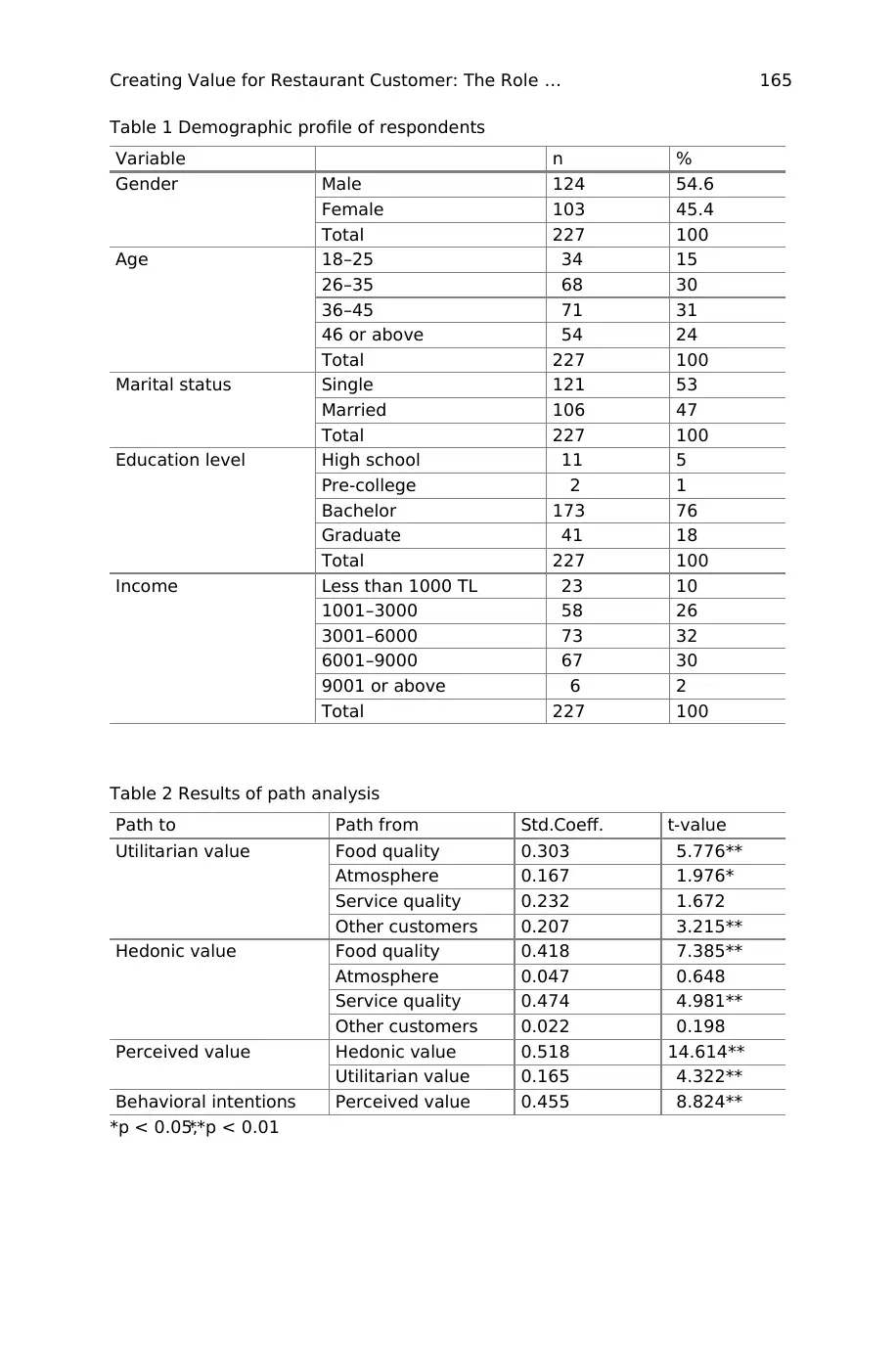
Table 1 Demographic profile of respondents
Variable n %
Gender Male 124 54.6
Female 103 45.4
Total 227 100
Age 18–25 34 15
26–35 68 30
36–45 71 31
46 or above 54 24
Total 227 100
Marital status Single 121 53
Married 106 47
Total 227 100
Education level High school 11 5
Pre-college 2 1
Bachelor 173 76
Graduate 41 18
Total 227 100
Income Less than 1000 TL 23 10
1001–3000 58 26
3001–6000 73 32
6001–9000 67 30
9001 or above 6 2
Total 227 100
Table 2 Results of path analysis
Path to Path from Std.Coeff. t-value
Utilitarian value Food quality 0.303 5.776**
Atmosphere 0.167 1.976*
Service quality 0.232 1.672
Other customers 0.207 3.215**
Hedonic value Food quality 0.418 7.385**
Atmosphere 0.047 0.648
Service quality 0.474 4.981**
Other customers 0.022 0.198
Perceived value Hedonic value 0.518 14.614**
Utilitarian value 0.165 4.322**
Behavioral intentions Perceived value 0.455 8.824**
*p < 0.05,**p < 0.01
Creating Value for Restaurant Customer: The Role … 165
Variable n %
Gender Male 124 54.6
Female 103 45.4
Total 227 100
Age 18–25 34 15
26–35 68 30
36–45 71 31
46 or above 54 24
Total 227 100
Marital status Single 121 53
Married 106 47
Total 227 100
Education level High school 11 5
Pre-college 2 1
Bachelor 173 76
Graduate 41 18
Total 227 100
Income Less than 1000 TL 23 10
1001–3000 58 26
3001–6000 73 32
6001–9000 67 30
9001 or above 6 2
Total 227 100
Table 2 Results of path analysis
Path to Path from Std.Coeff. t-value
Utilitarian value Food quality 0.303 5.776**
Atmosphere 0.167 1.976*
Service quality 0.232 1.672
Other customers 0.207 3.215**
Hedonic value Food quality 0.418 7.385**
Atmosphere 0.047 0.648
Service quality 0.474 4.981**
Other customers 0.022 0.198
Perceived value Hedonic value 0.518 14.614**
Utilitarian value 0.165 4.322**
Behavioral intentions Perceived value 0.455 8.824**
*p < 0.05,**p < 0.01
Creating Value for Restaurant Customer: The Role … 165
⊘ This is a preview!⊘
Do you want full access?
Subscribe today to unlock all pages.

Trusted by 1+ million students worldwide
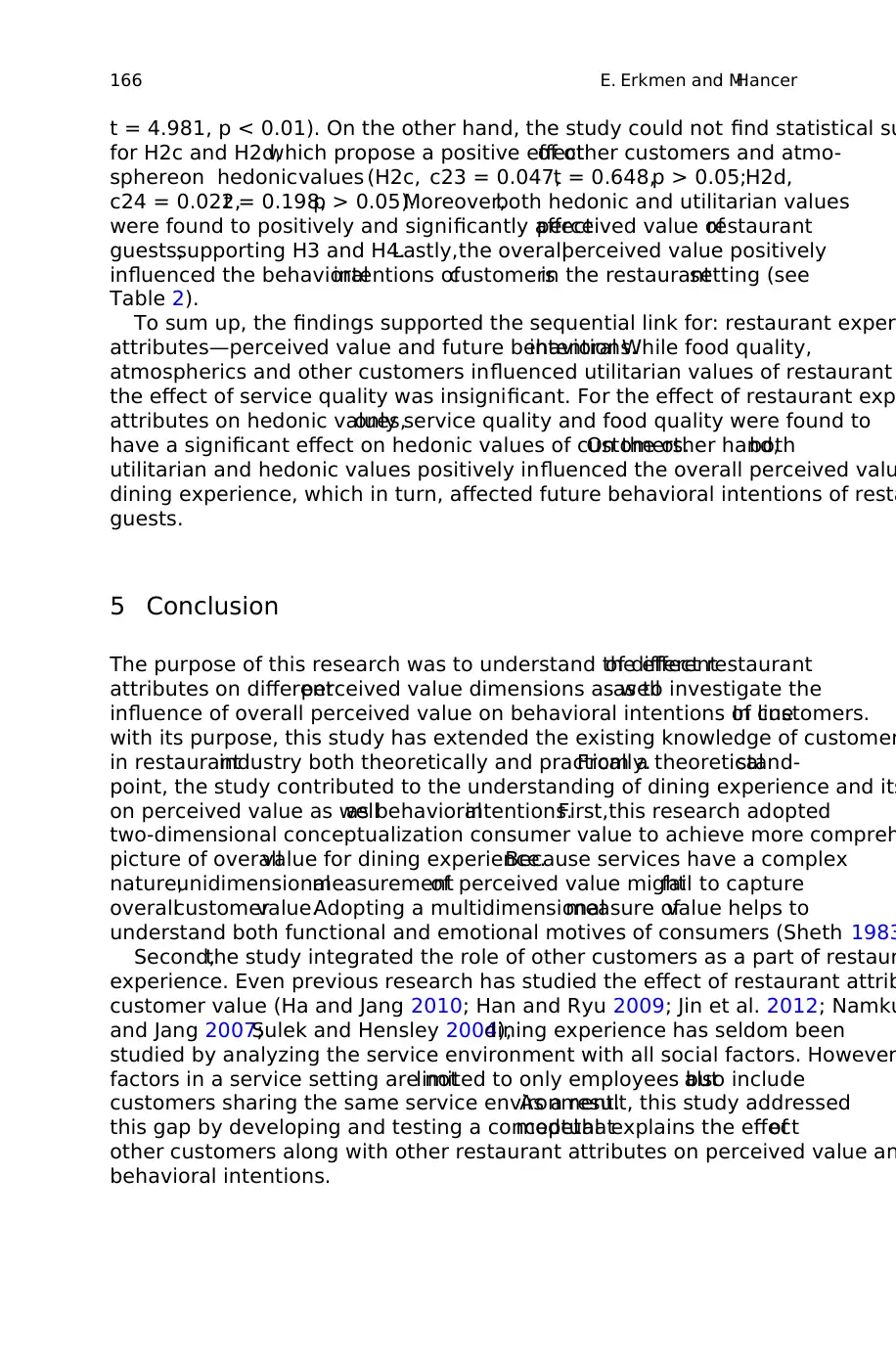
t = 4.981, p < 0.01). On the other hand, the study could not find statistical su
for H2c and H2d,which propose a positive effectof other customers and atmo-
sphereon hedonicvalues (H2c, c23 = 0.047,t = 0.648,p > 0.05;H2d,
c24 = 0.022,t = 0.198,p > 0.05).Moreover,both hedonic and utilitarian values
were found to positively and significantly affectperceived value ofrestaurant
guests,supporting H3 and H4.Lastly,the overallperceived value positively
influenced the behavioralintentions ofcustomersin the restaurantsetting (see
Table 2).
To sum up, the findings supported the sequential link for: restaurant exper
attributes—perceived value and future behavioralintentions.While food quality,
atmospherics and other customers influenced utilitarian values of restaurant
the effect of service quality was insignificant. For the effect of restaurant exp
attributes on hedonic values,only service quality and food quality were found to
have a significant effect on hedonic values of customers.On the other hand,both
utilitarian and hedonic values positively influenced the overall perceived valu
dining experience, which in turn, affected future behavioral intentions of resta
guests.
5 Conclusion
The purpose of this research was to understand the effectof differentrestaurant
attributes on differentperceived value dimensions as wellas to investigate the
influence of overall perceived value on behavioral intentions of customers.In line
with its purpose, this study has extended the existing knowledge of customer
in restaurantindustry both theoretically and practically.From a theoreticalstand-
point, the study contributed to the understanding of dining experience and its
on perceived value as wellas behavioralintentions.First,this research adopted
two-dimensional conceptualization consumer value to achieve more compreh
picture of overallvalue for dining experience.Because services have a complex
nature,unidimensionalmeasurementof perceived value mightfail to capture
overallcustomervalue.Adopting a multidimensionalmeasure ofvalue helps to
understand both functional and emotional motives of consumers (Sheth 1983
Second,the study integrated the role of other customers as a part of restaur
experience. Even previous research has studied the effect of restaurant attrib
customer value (Ha and Jang 2010; Han and Ryu 2009; Jin et al. 2012; Namku
and Jang 2007;Sulek and Hensley 2004),dining experience has seldom been
studied by analyzing the service environment with all social factors. However
factors in a service setting are notlimited to only employees butalso include
customers sharing the same service environment.As a result, this study addressed
this gap by developing and testing a conceptualmodelthatexplains the effectof
other customers along with other restaurant attributes on perceived value an
behavioral intentions.
166 E. Erkmen and M.Hancer
for H2c and H2d,which propose a positive effectof other customers and atmo-
sphereon hedonicvalues (H2c, c23 = 0.047,t = 0.648,p > 0.05;H2d,
c24 = 0.022,t = 0.198,p > 0.05).Moreover,both hedonic and utilitarian values
were found to positively and significantly affectperceived value ofrestaurant
guests,supporting H3 and H4.Lastly,the overallperceived value positively
influenced the behavioralintentions ofcustomersin the restaurantsetting (see
Table 2).
To sum up, the findings supported the sequential link for: restaurant exper
attributes—perceived value and future behavioralintentions.While food quality,
atmospherics and other customers influenced utilitarian values of restaurant
the effect of service quality was insignificant. For the effect of restaurant exp
attributes on hedonic values,only service quality and food quality were found to
have a significant effect on hedonic values of customers.On the other hand,both
utilitarian and hedonic values positively influenced the overall perceived valu
dining experience, which in turn, affected future behavioral intentions of resta
guests.
5 Conclusion
The purpose of this research was to understand the effectof differentrestaurant
attributes on differentperceived value dimensions as wellas to investigate the
influence of overall perceived value on behavioral intentions of customers.In line
with its purpose, this study has extended the existing knowledge of customer
in restaurantindustry both theoretically and practically.From a theoreticalstand-
point, the study contributed to the understanding of dining experience and its
on perceived value as wellas behavioralintentions.First,this research adopted
two-dimensional conceptualization consumer value to achieve more compreh
picture of overallvalue for dining experience.Because services have a complex
nature,unidimensionalmeasurementof perceived value mightfail to capture
overallcustomervalue.Adopting a multidimensionalmeasure ofvalue helps to
understand both functional and emotional motives of consumers (Sheth 1983
Second,the study integrated the role of other customers as a part of restaur
experience. Even previous research has studied the effect of restaurant attrib
customer value (Ha and Jang 2010; Han and Ryu 2009; Jin et al. 2012; Namku
and Jang 2007;Sulek and Hensley 2004),dining experience has seldom been
studied by analyzing the service environment with all social factors. However
factors in a service setting are notlimited to only employees butalso include
customers sharing the same service environment.As a result, this study addressed
this gap by developing and testing a conceptualmodelthatexplains the effectof
other customers along with other restaurant attributes on perceived value an
behavioral intentions.
166 E. Erkmen and M.Hancer
Paraphrase This Document
Need a fresh take? Get an instant paraphrase of this document with our AI Paraphraser
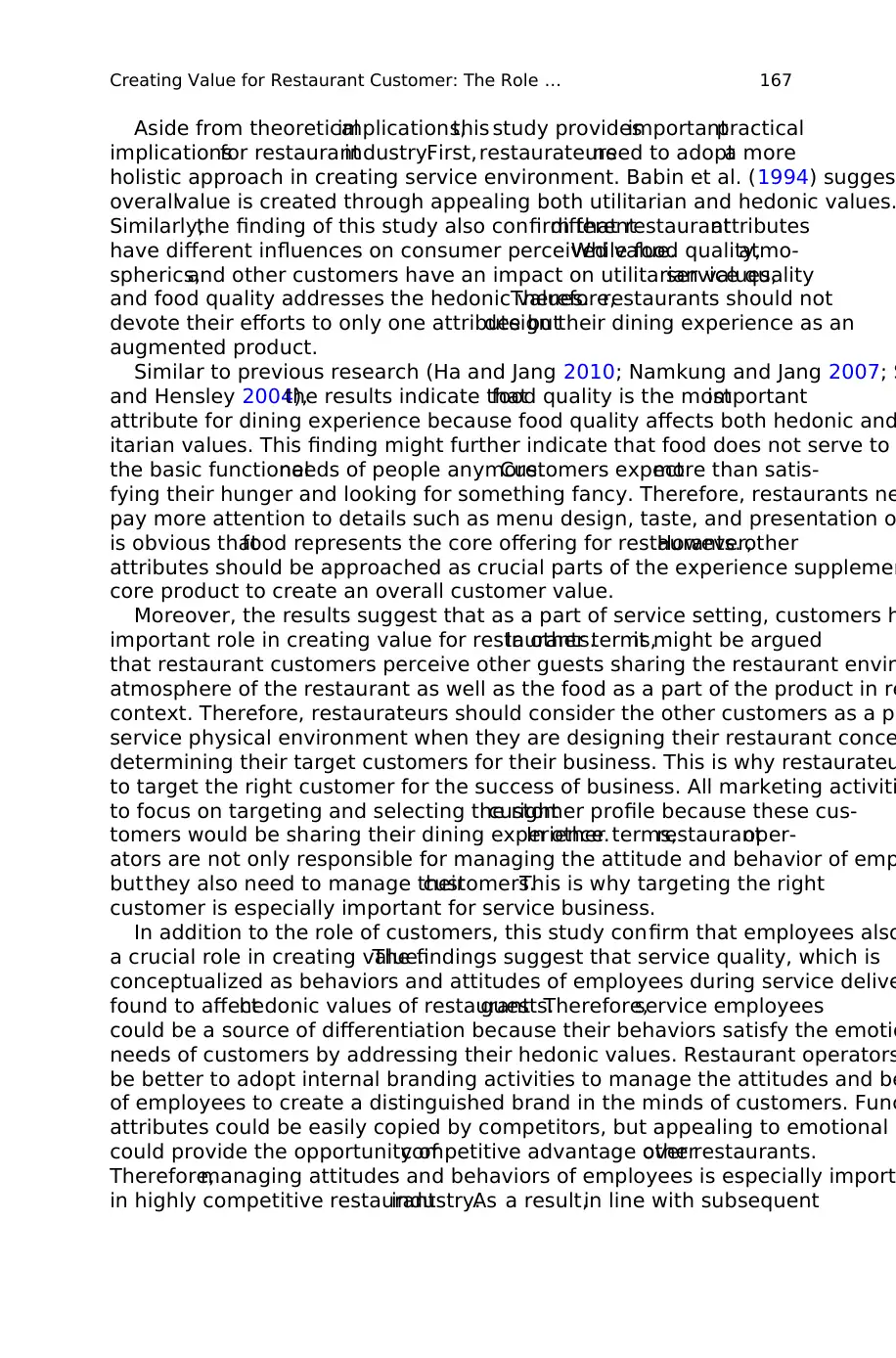
Aside from theoreticalimplications,this study providesimportantpractical
implicationsfor restaurantindustry.First, restaurateursneed to adopta more
holistic approach in creating service environment. Babin et al. (1994) sugges
overallvalue is created through appealing both utilitarian and hedonic values.
Similarly,the finding of this study also confirm thatdifferentrestaurantattributes
have different influences on consumer perceived value.While food quality,atmo-
spherics,and other customers have an impact on utilitarian values,service quality
and food quality addresses the hedonic values.Therefore,restaurants should not
devote their efforts to only one attribute butdesign their dining experience as an
augmented product.
Similar to previous research (Ha and Jang 2010; Namkung and Jang 2007; S
and Hensley 2004),the results indicate thatfood quality is the mostimportant
attribute for dining experience because food quality affects both hedonic and
itarian values. This finding might further indicate that food does not serve to
the basic functionalneeds of people anymore.Customers expectmore than satis-
fying their hunger and looking for something fancy. Therefore, restaurants ne
pay more attention to details such as menu design, taste, and presentation o
is obvious thatfood represents the core offering for restaurants.However,other
attributes should be approached as crucial parts of the experience supplemen
core product to create an overall customer value.
Moreover, the results suggest that as a part of service setting, customers h
important role in creating value for restaurants.In other terms,it might be argued
that restaurant customers perceive other guests sharing the restaurant envir
atmosphere of the restaurant as well as the food as a part of the product in re
context. Therefore, restaurateurs should consider the other customers as a pa
service physical environment when they are designing their restaurant conce
determining their target customers for their business. This is why restaurateu
to target the right customer for the success of business. All marketing activiti
to focus on targeting and selecting the rightcustomer profile because these cus-
tomers would be sharing their dining experience.In other terms,restaurantoper-
ators are not only responsible for managing the attitude and behavior of emp
butthey also need to manage theircustomers.This is why targeting the right
customer is especially important for service business.
In addition to the role of customers, this study confirm that employees also
a crucial role in creating value.The findings suggest that service quality, which is
conceptualized as behaviors and attitudes of employees during service delive
found to affecthedonic values of restaurantguests.Therefore,service employees
could be a source of differentiation because their behaviors satisfy the emotio
needs of customers by addressing their hedonic values. Restaurant operators
be better to adopt internal branding activities to manage the attitudes and be
of employees to create a distinguished brand in the minds of customers. Func
attributes could be easily copied by competitors, but appealing to emotional n
could provide the opportunity ofcompetitive advantage overotherrestaurants.
Therefore,managing attitudes and behaviors of employees is especially import
in highly competitive restaurantindustry.As a result,in line with subsequent
Creating Value for Restaurant Customer: The Role … 167
implicationsfor restaurantindustry.First, restaurateursneed to adopta more
holistic approach in creating service environment. Babin et al. (1994) sugges
overallvalue is created through appealing both utilitarian and hedonic values.
Similarly,the finding of this study also confirm thatdifferentrestaurantattributes
have different influences on consumer perceived value.While food quality,atmo-
spherics,and other customers have an impact on utilitarian values,service quality
and food quality addresses the hedonic values.Therefore,restaurants should not
devote their efforts to only one attribute butdesign their dining experience as an
augmented product.
Similar to previous research (Ha and Jang 2010; Namkung and Jang 2007; S
and Hensley 2004),the results indicate thatfood quality is the mostimportant
attribute for dining experience because food quality affects both hedonic and
itarian values. This finding might further indicate that food does not serve to
the basic functionalneeds of people anymore.Customers expectmore than satis-
fying their hunger and looking for something fancy. Therefore, restaurants ne
pay more attention to details such as menu design, taste, and presentation o
is obvious thatfood represents the core offering for restaurants.However,other
attributes should be approached as crucial parts of the experience supplemen
core product to create an overall customer value.
Moreover, the results suggest that as a part of service setting, customers h
important role in creating value for restaurants.In other terms,it might be argued
that restaurant customers perceive other guests sharing the restaurant envir
atmosphere of the restaurant as well as the food as a part of the product in re
context. Therefore, restaurateurs should consider the other customers as a pa
service physical environment when they are designing their restaurant conce
determining their target customers for their business. This is why restaurateu
to target the right customer for the success of business. All marketing activiti
to focus on targeting and selecting the rightcustomer profile because these cus-
tomers would be sharing their dining experience.In other terms,restaurantoper-
ators are not only responsible for managing the attitude and behavior of emp
butthey also need to manage theircustomers.This is why targeting the right
customer is especially important for service business.
In addition to the role of customers, this study confirm that employees also
a crucial role in creating value.The findings suggest that service quality, which is
conceptualized as behaviors and attitudes of employees during service delive
found to affecthedonic values of restaurantguests.Therefore,service employees
could be a source of differentiation because their behaviors satisfy the emotio
needs of customers by addressing their hedonic values. Restaurant operators
be better to adopt internal branding activities to manage the attitudes and be
of employees to create a distinguished brand in the minds of customers. Func
attributes could be easily copied by competitors, but appealing to emotional n
could provide the opportunity ofcompetitive advantage overotherrestaurants.
Therefore,managing attitudes and behaviors of employees is especially import
in highly competitive restaurantindustry.As a result,in line with subsequent
Creating Value for Restaurant Customer: The Role … 167
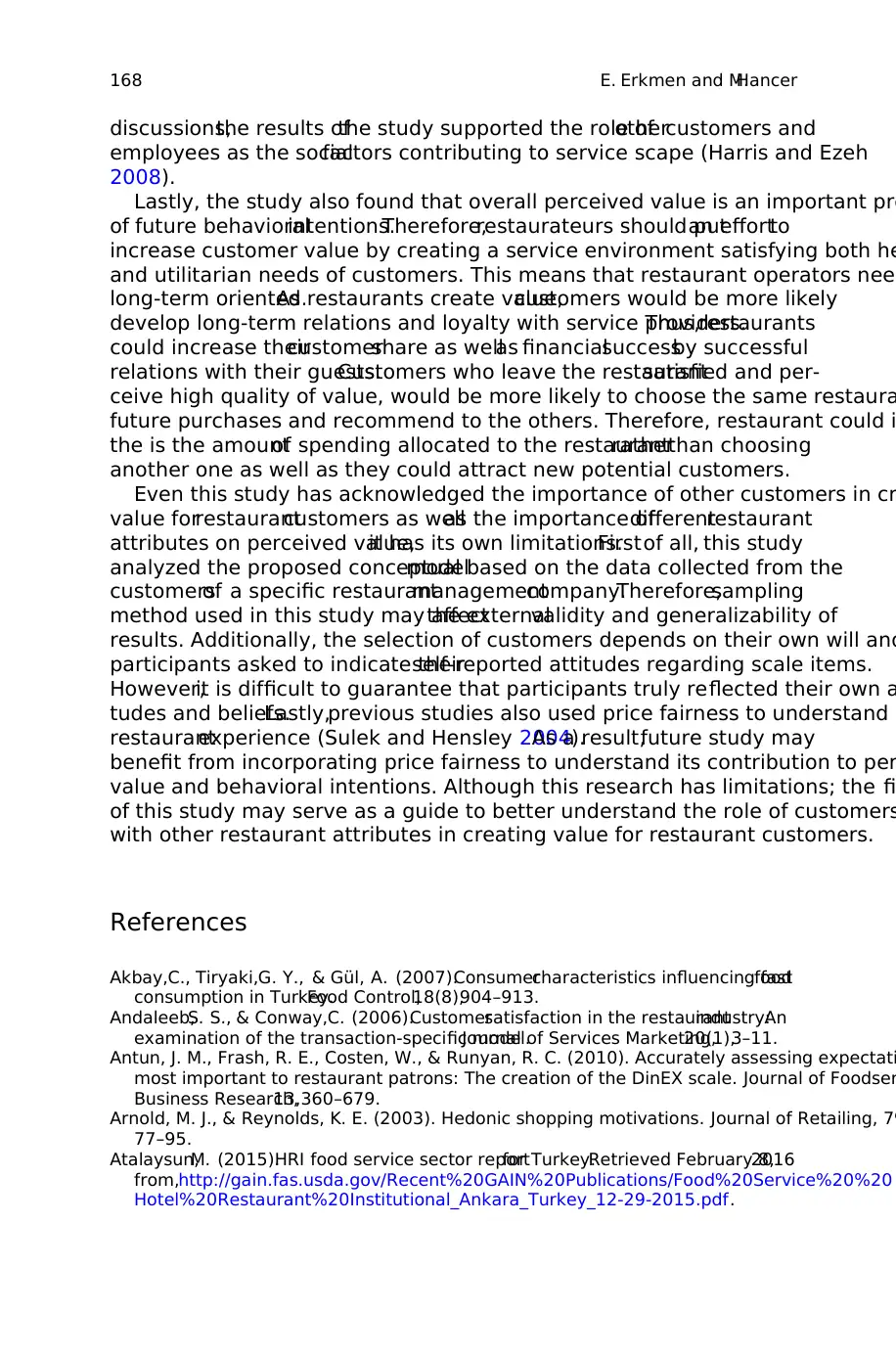
discussions,the results ofthe study supported the role ofothercustomers and
employees as the socialfactors contributing to service scape (Harris and Ezeh
2008).
Lastly, the study also found that overall perceived value is an important pre
of future behavioralintentions.Therefore,restaurateurs should putan effortto
increase customer value by creating a service environment satisfying both he
and utilitarian needs of customers. This means that restaurant operators need
long-term oriented.As restaurants create value,customers would be more likely
develop long-term relations and loyalty with service providers.Thus,restaurants
could increase theircustomershare as wellas financialsuccessby successful
relations with their guests.Customers who leave the restaurantsatisfied and per-
ceive high quality of value, would be more likely to choose the same restaura
future purchases and recommend to the others. Therefore, restaurant could i
the is the amountof spending allocated to the restaurantratherthan choosing
another one as well as they could attract new potential customers.
Even this study has acknowledged the importance of other customers in cr
value forrestaurantcustomers as wellas the importance ofdifferentrestaurant
attributes on perceived value,it has its own limitations.Firstof all, this study
analyzed the proposed conceptualmodelbased on the data collected from the
customersof a specific restaurantmanagementcompany.Therefore,sampling
method used in this study may affectthe externalvalidity and generalizability of
results. Additionally, the selection of customers depends on their own will and
participants asked to indicate theirself-reported attitudes regarding scale items.
However,it is difficult to guarantee that participants truly reflected their own a
tudes and beliefs.Lastly,previous studies also used price fairness to understand
restaurantexperience (Sulek and Hensley 2004).As a result,future study may
benefit from incorporating price fairness to understand its contribution to per
value and behavioral intentions. Although this research has limitations; the fi
of this study may serve as a guide to better understand the role of customers
with other restaurant attributes in creating value for restaurant customers.
References
Akbay,C., Tiryaki,G. Y., & Gül, A. (2007).Consumercharacteristics influencing fastfood
consumption in Turkey.Food Control,18(8),904–913.
Andaleeb,S. S., & Conway,C. (2006).Customersatisfaction in the restaurantindustry:An
examination of the transaction-specific model.Journal of Services Marketing,20(1),3–11.
Antun, J. M., Frash, R. E., Costen, W., & Runyan, R. C. (2010). Accurately assessing expectati
most important to restaurant patrons: The creation of the DinEX scale. Journal of Foodser
Business Research,13,360–679.
Arnold, M. J., & Reynolds, K. E. (2003). Hedonic shopping motivations. Journal of Retailing, 79
77–95.
Atalaysun,M. (2015).HRI food service sector reportfor Turkey.Retrieved February 8,2016
from,http://gain.fas.usda.gov/Recent%20GAIN%20Publications/Food%20Service%20%20
Hotel%20Restaurant%20Institutional_Ankara_Turkey_12-29-2015.pdf.
168 E. Erkmen and M.Hancer
employees as the socialfactors contributing to service scape (Harris and Ezeh
2008).
Lastly, the study also found that overall perceived value is an important pre
of future behavioralintentions.Therefore,restaurateurs should putan effortto
increase customer value by creating a service environment satisfying both he
and utilitarian needs of customers. This means that restaurant operators need
long-term oriented.As restaurants create value,customers would be more likely
develop long-term relations and loyalty with service providers.Thus,restaurants
could increase theircustomershare as wellas financialsuccessby successful
relations with their guests.Customers who leave the restaurantsatisfied and per-
ceive high quality of value, would be more likely to choose the same restaura
future purchases and recommend to the others. Therefore, restaurant could i
the is the amountof spending allocated to the restaurantratherthan choosing
another one as well as they could attract new potential customers.
Even this study has acknowledged the importance of other customers in cr
value forrestaurantcustomers as wellas the importance ofdifferentrestaurant
attributes on perceived value,it has its own limitations.Firstof all, this study
analyzed the proposed conceptualmodelbased on the data collected from the
customersof a specific restaurantmanagementcompany.Therefore,sampling
method used in this study may affectthe externalvalidity and generalizability of
results. Additionally, the selection of customers depends on their own will and
participants asked to indicate theirself-reported attitudes regarding scale items.
However,it is difficult to guarantee that participants truly reflected their own a
tudes and beliefs.Lastly,previous studies also used price fairness to understand
restaurantexperience (Sulek and Hensley 2004).As a result,future study may
benefit from incorporating price fairness to understand its contribution to per
value and behavioral intentions. Although this research has limitations; the fi
of this study may serve as a guide to better understand the role of customers
with other restaurant attributes in creating value for restaurant customers.
References
Akbay,C., Tiryaki,G. Y., & Gül, A. (2007).Consumercharacteristics influencing fastfood
consumption in Turkey.Food Control,18(8),904–913.
Andaleeb,S. S., & Conway,C. (2006).Customersatisfaction in the restaurantindustry:An
examination of the transaction-specific model.Journal of Services Marketing,20(1),3–11.
Antun, J. M., Frash, R. E., Costen, W., & Runyan, R. C. (2010). Accurately assessing expectati
most important to restaurant patrons: The creation of the DinEX scale. Journal of Foodser
Business Research,13,360–679.
Arnold, M. J., & Reynolds, K. E. (2003). Hedonic shopping motivations. Journal of Retailing, 79
77–95.
Atalaysun,M. (2015).HRI food service sector reportfor Turkey.Retrieved February 8,2016
from,http://gain.fas.usda.gov/Recent%20GAIN%20Publications/Food%20Service%20%20
Hotel%20Restaurant%20Institutional_Ankara_Turkey_12-29-2015.pdf.
168 E. Erkmen and M.Hancer
⊘ This is a preview!⊘
Do you want full access?
Subscribe today to unlock all pages.

Trusted by 1+ million students worldwide
1 out of 15
Related Documents
Your All-in-One AI-Powered Toolkit for Academic Success.
+13062052269
info@desklib.com
Available 24*7 on WhatsApp / Email
![[object Object]](/_next/static/media/star-bottom.7253800d.svg)
Unlock your academic potential
Copyright © 2020–2025 A2Z Services. All Rights Reserved. Developed and managed by ZUCOL.




